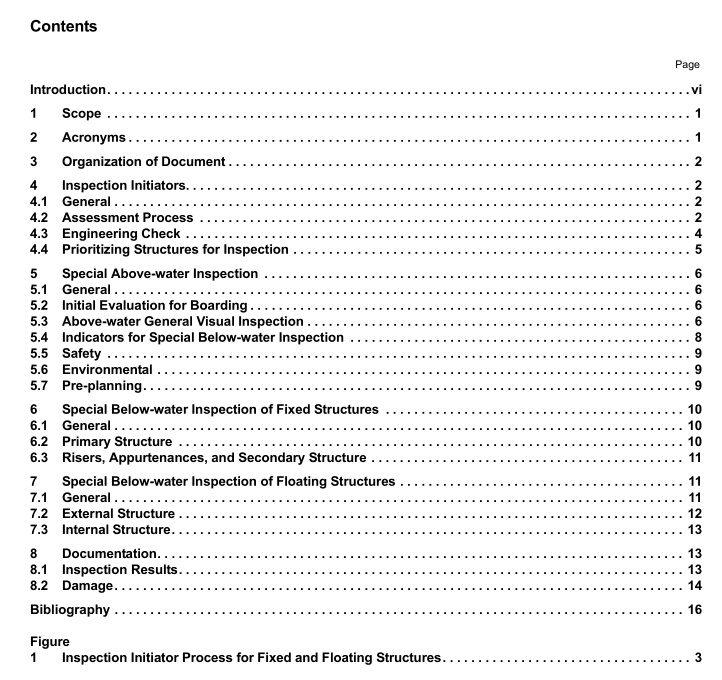API Bull 2HINS pdf download

API Bull 2HINS pdf download Guidance for Post-hurricane Structural Inspection of Offshore Structures
3 organization of Document
This document is organized in a progressive manner such that the user starts with the early sections to determine theneed for post-huricane inspections. if inspections are required, the later sections provide specitic guidance.Section 4describes the initiators to determine the need for and the general extent of inspections that should be performed.Section 5 provides guidance for safe initial boarding of the structure as well as guidance for the above-water structureinspection. The above-water inspections also assist in establishing the need for below-water inspections. Section 6provides guidance for below-water inspection of fixed structures.Section 7 provides guidance for below-waterinspection of the external and internal structure of floating structures. Section 8 provides guidance for documentation.4lnspection lnitiators
4.1General
After a hurricane has passed through the Gulf of Mexico,inspection initiators determine if an offshore structurerequires a special post-hurricane structural inspection. The inspection initiators are based upon the following:
-the structure’s exposure to hurricane conditions; and
indications that the structure has suffered damage, as in the case where large objects may have fallen overboardor the structure is leaning, tilted or listing.
For the purposes of this document,a hurricane event is a named tropical cyclone, as defined by the NationalHurricane Center(NHC), which enters or generates in the Gulf of Mexico. The NHC is the official U.S. agency forestablishing hurricanes.NHC defines a hurricane as a storm with maximum sustained 1-minute surface winds greaterthan or equal to 74 mph(64 kt). Surface winds are those observed to occur at the standard meteorological height of10 m (33 fty in an unobstructed exposure.
4.2Assessment Process
The process for determining if a structure should be inspected following a hurricane is shown in Figure 1.This is aprogressive approach based on the huricane conditions experienced by the structure and on results from above-water inspections of the primary structure and from other damage indicators.
The process for a particular structure is initiated when the structure has been exposed to wind speeds equal to orgreater than huricane conditions, as defined in 4.1.The wind speed used in this determination, can be based uponany of the following:
measured wind speeds at the structure location, using calibrated monitoring equipment demonstrated to beaccurate and operating continuously throughout the duration of the hurricane;
– maximum hurricane wind speed based upon hindcast data, using generally accepted meteorological practices.
A special above-water inspection should be performed once it is determined the structure has been subjected tohurricane winds or greater. The intent of this inspection is to gain a general understanding of the condition of thestructure to determine if it is safe for boarding, if above-water damage is evident and if any large objects have fallenoverboard possibly damaging the structure below water.Guidance for the special above-water inspection is providedin Section 5.
An engineering check should be performed in those cases when no structural damage is apparent in order todetermine whether the hurricane conditions at the site or the structure response exceeded the limits beyond whichthe structure may have suffered damage. This can be a simple comparison of the hurricane conditions experiencedby the structure to the structure’s design environmental conditions, or a more detailed engineering study intended todetermine if the hurricane loads or structure motions were sufficient to cause damage. If the engineering check shows that damage is likely, then a special below-water inspection should be performed. If the engineering check indicates no structural damage is likely and no structural damage was found during the special above-water inspection, generally no further action is required, unless there are structure-specific post-hurricane inspections stipulated by owner/operator requirements, class or regulatory requirements. Guidance for the engineering check is provided in 4.3.
A special below-water inspection should be performed when the special above-water inspection finds structural damage indicating potential below-water damage, or when the results of the engineering check indicate that the structure could be damaged below-water. The scope and methods of the below-water inspection are dependent upon the findings of the special above-water inspection and/or the results of the engineering check. Guidance for the special below-water inspection for fixed and floating structures is provided in Section 6 and Section 7.









